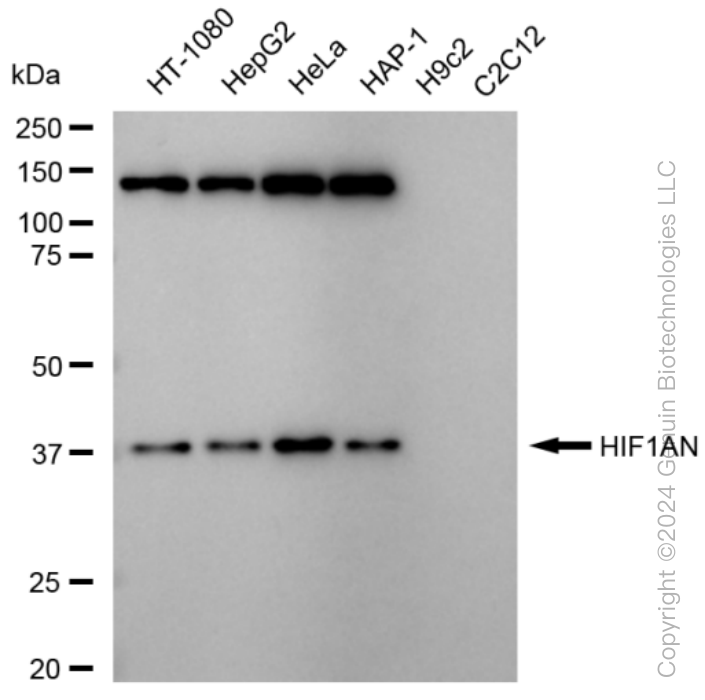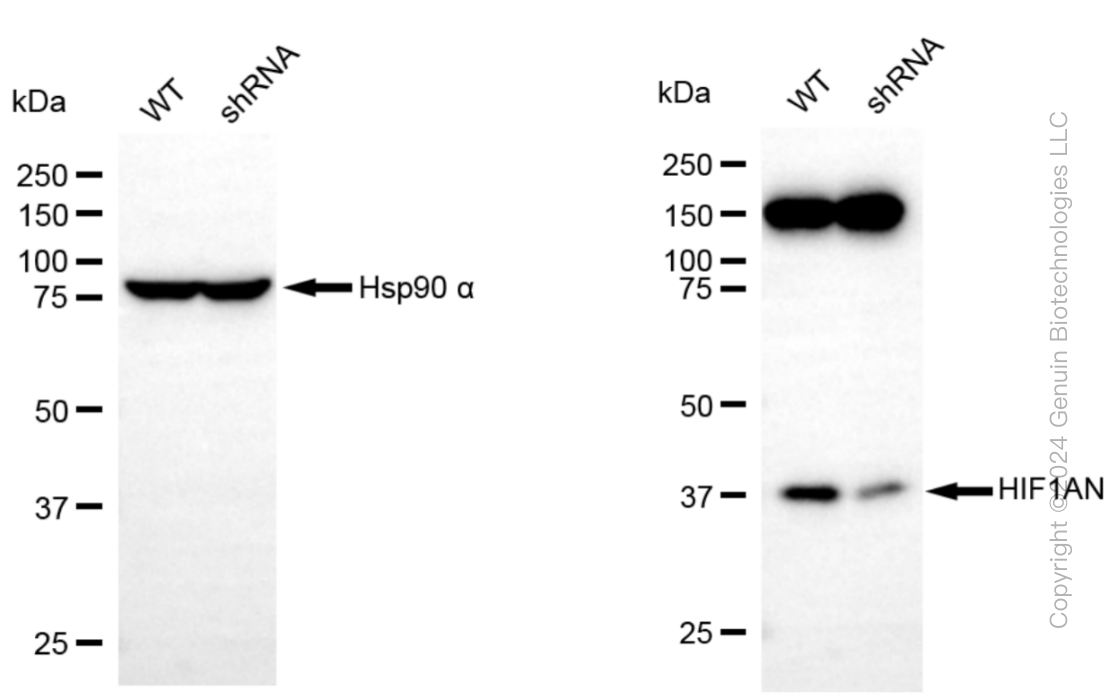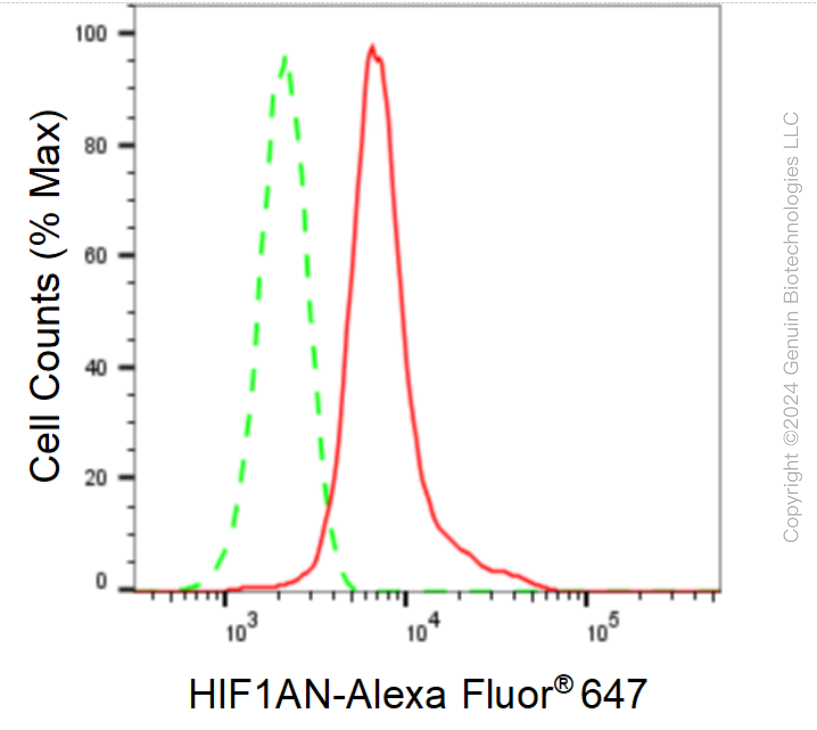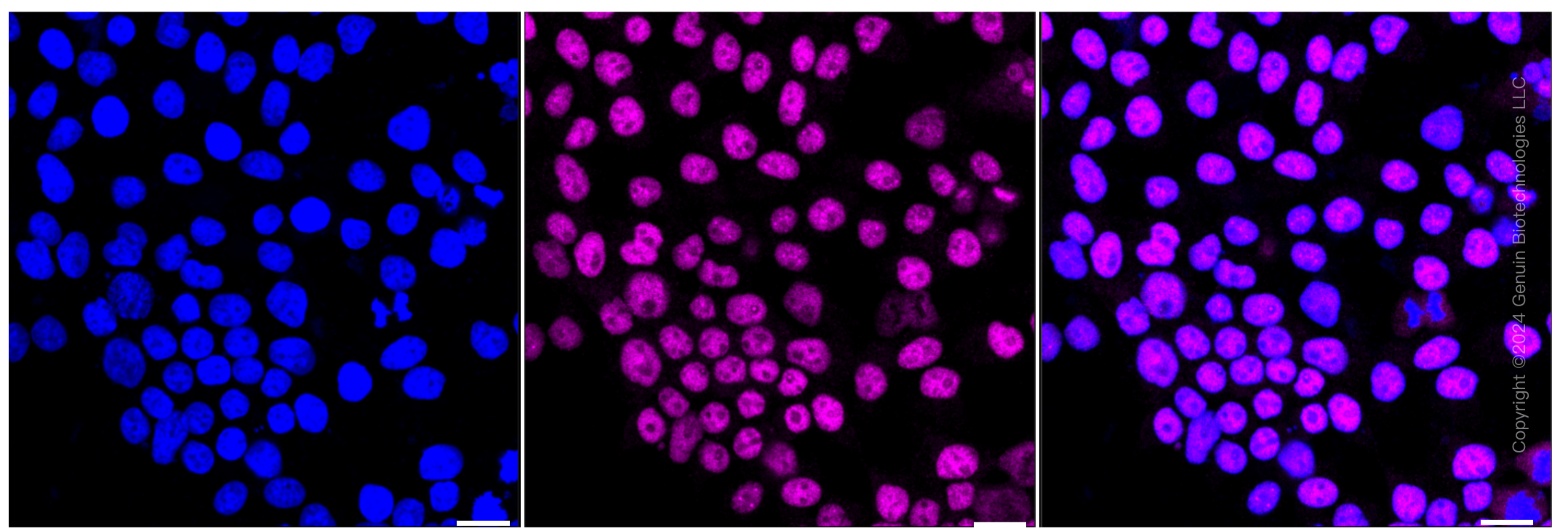KD-Validated Anti-HIF1AN Rabbit Monoclonal Antibody
Rabbit monoclonal antibody
- SPECIFICATION
- CITATIONS
- PROTOCOLS
- BACKGROUND

Application
| WB, FC, ICC |
|---|---|
| Primary Accession | Q9NWT6 |
| Reactivity | Human |
| Clonality | Monoclonal |
| Isotype | Rabbit IgG |
| Clone Names | 23GB6385 |
| Calculated MW | Predicted, 40 kDa , observed , 40 kDa |
| Gene Name | HIF1AN |
| Aliases | HIF1AN; Hypoxia Inducible Factor 1 Subunit Alpha Inhibitor; FIH1; Hypoxia-Inducible Factor Asparagine Hydroxylase; Hypoxia-Inducible Factor 1-Alpha Inhibitor; Peptide-Aspartate Beta-Dioxygenase; Factor Inhibiting HIF-1; FLJ20615; FLJ22027; FIH-1; Hypoxia Inducible Factor 1 Alpha Subunit Inhibitor; Factor Inhibiting HIF1; DKFZp762F1811; DKFZP762F1811; EC 1.14.11.30; EC 1.14.11.N4 |
| Immunogen | A synthesized peptide derived from human HIF1AN |
| Gene ID | 55662 |
|---|---|
| Other Names | Hypoxia-inducible factor 1-alpha inhibitor, 1.14.11.30, 1.14.11.n4, Factor inhibiting HIF-1, FIH-1, Hypoxia-inducible factor asparagine hydroxylase, HIF1AN, FIH1 |
| Name | HIF1AN |
|---|---|
| Synonyms | FIH1 |
| Function | Hydroxylates HIF-1 alpha at 'Asn-803' in the C-terminal transactivation domain (CAD). Functions as an oxygen sensor and, under normoxic conditions, the hydroxylation prevents interaction of HIF-1 with transcriptional coactivators including Cbp/p300-interacting transactivator. Involved in transcriptional repression through interaction with HIF1A, VHL and histone deacetylases. Hydroxylates specific Asn residues within ankyrin repeat domains (ARD) of NFKB1, NFKBIA, NOTCH1, ASB4, PPP1R12A and several other ARD-containing proteins. Also hydroxylates Asp and His residues within ARDs of ANK1 and TNKS2, respectively. Negatively regulates NOTCH1 activity, accelerating myogenic differentiation. Positively regulates ASB4 activity, promoting vascular differentiation. |
| Cellular Location | Nucleus. Cytoplasm. Cytoplasm, perinuclear region. Note=Mainly cytoplasmic localization, but interaction with NOTCH1 results in nuclear localization and interaction with ABPA3 results in perinuclear localization in macrophages |

Thousands of laboratories across the world have published research that depended on the performance of antibodies from Abcepta to advance their research. Check out links to articles that cite our products in major peer-reviewed journals, organized by research category.
info@abcepta.com, and receive a free "I Love Antibodies" mug.
Provided below are standard protocols that you may find useful for product applications.
If you have used an Abcepta product and would like to share how it has performed, please click on the "Submit Review" button and provide the requested information. Our staff will examine and post your review and contact you if needed.
If you have any additional inquiries please email technical services at tech@abcepta.com.














 Foundational characteristics of cancer include proliferation, angiogenesis, migration, evasion of apoptosis, and cellular immortality. Find key markers for these cellular processes and antibodies to detect them.
Foundational characteristics of cancer include proliferation, angiogenesis, migration, evasion of apoptosis, and cellular immortality. Find key markers for these cellular processes and antibodies to detect them. The SUMOplot™ Analysis Program predicts and scores sumoylation sites in your protein. SUMOylation is a post-translational modification involved in various cellular processes, such as nuclear-cytosolic transport, transcriptional regulation, apoptosis, protein stability, response to stress, and progression through the cell cycle.
The SUMOplot™ Analysis Program predicts and scores sumoylation sites in your protein. SUMOylation is a post-translational modification involved in various cellular processes, such as nuclear-cytosolic transport, transcriptional regulation, apoptosis, protein stability, response to stress, and progression through the cell cycle. The Autophagy Receptor Motif Plotter predicts and scores autophagy receptor binding sites in your protein. Identifying proteins connected to this pathway is critical to understanding the role of autophagy in physiological as well as pathological processes such as development, differentiation, neurodegenerative diseases, stress, infection, and cancer.
The Autophagy Receptor Motif Plotter predicts and scores autophagy receptor binding sites in your protein. Identifying proteins connected to this pathway is critical to understanding the role of autophagy in physiological as well as pathological processes such as development, differentiation, neurodegenerative diseases, stress, infection, and cancer.





